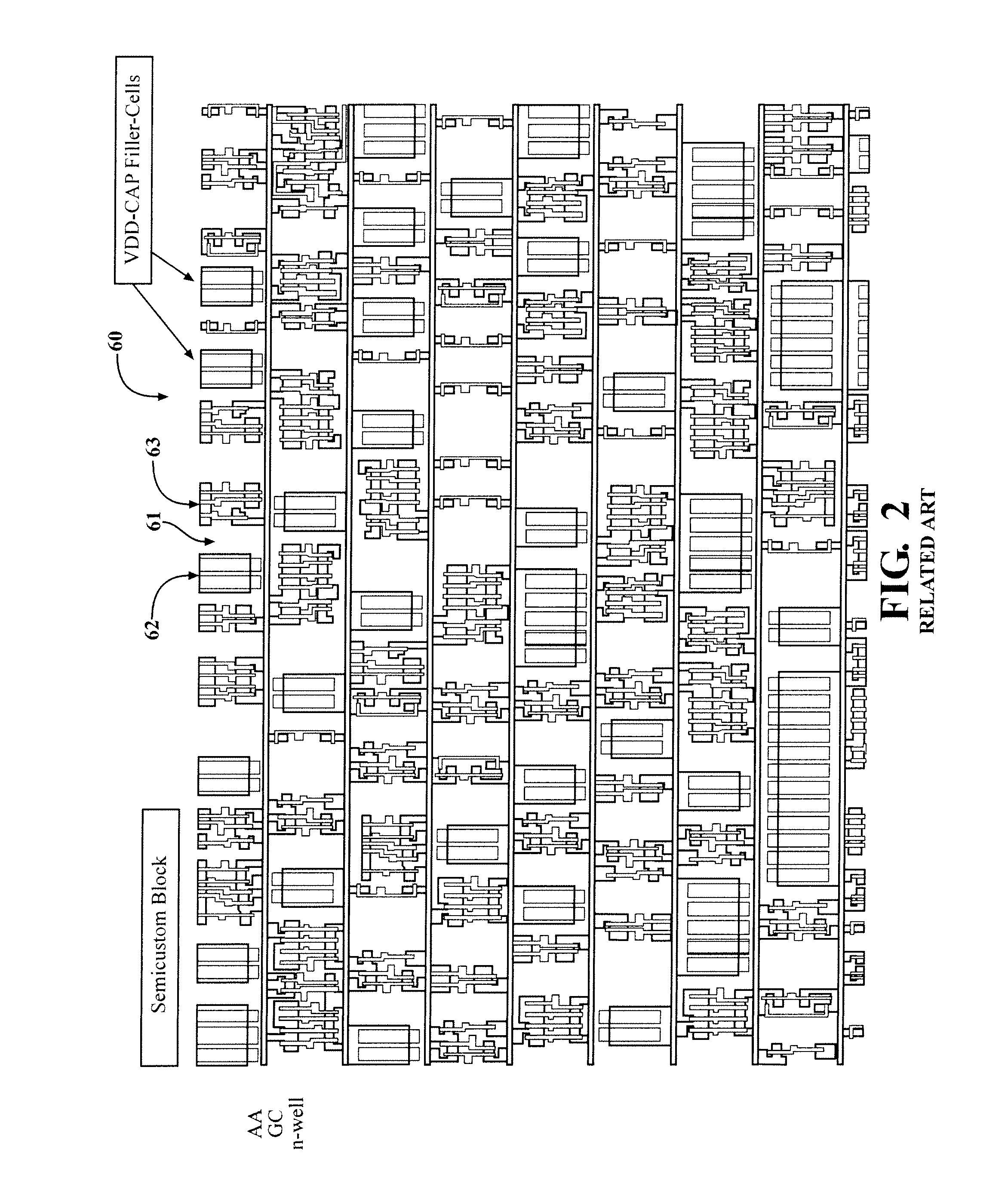Shallow trench isolation area having buried capacitor
a capacitor and trench isolation technology, applied in the field of semiconductor devices, can solve the problems of inefficiency, achieve the effect of improving chip performance, high capacitance level, and efficient utilization of chip spa
- Summary
- Abstract
- Description
- Claims
- Application Information
AI Technical Summary
Benefits of technology
Problems solved by technology
Method used
Image
Examples
first embodiment
[0046]FIG. 3 depicts a cross-sectional view of a semiconductor chip having STI areas with buried buffer capacitors according to a As shown in FIG. 3, a semiconductor chip 10 includes a shallow trench isolation (STI) area 11 having buffer capacitors 12 buried therein, where the buffer capacitors 12 are arranged in a buried line-to-line configuration in which the buffer capacitors 12 are connected via lines in a serial fashion. In this embodiment, the STI area 11 separates the active transistor region 17 and the substrate contact region 18 from each other to prevent electrical current leakage from affecting performance.
[0047]The semiconductor chip 10 further includes a metal layer 19 (M1) to transmit electric current. Additionally, the semiconductor chip 10 includes gate electrode stacks (GC) 19a. The gate electrode stacks 19a may be designed by adding a thin layer of gate oxide on top of the silicon surface 14, adding a conducting layer of polysilicon over the gate oxide, and then a...
third embodiment
[0056]FIG. 5a depicts a cross-sectional view of a semiconductor chip having STI areas with buried buffer capacitors according to a As shown in FIG. 5a, a semiconductor chip 30 includes a shallow trench isolation (STI) area 31 having a buffer capacitor 32 completely buried therein (STI B CAP). The buffer capacitor 32 has a lower plate 34 and an upper plate 35 separated by an insulator 38. The STI area 31 separates the active transistor region 33 and the substrate contact region 37 from each other to prevent electrical current leakage from affecting performance.
[0057]As shown in the bottom of FIG. 5a, which depicts an exploded view of the third STI area 31, this third embodiment also uses a classic parallel plate capacitor design of two electrically conducting plates 34 and 35 that are separated from each other by an insulator 38 and arranged horizontally above each other. The plates 34 and 35 are distinguished from conventional architecture since they are completely buried in the ST...
fourth embodiment
[0059]FIG. 6 depicts a cross-sectional view of a semiconductor chip having STI areas with buried buffer capacitors according to a As shown in FIG. 6, a semiconductor chip 40 includes a shallow trench isolation (STI) area 41 having multiple buffer capacitors 42 buried therein. Each of the buffer capacitors 42 includes a lower plate 44 and an upper plate 45 separated by an insulator 48. The STI area 41 separates the active transistor region 43 and the substrate contact region 47 from each other to prevent electrical current leakage from affecting performance.
[0060]As shown in the bottom of FIG. 6, which depicts an exploded view of the STI area 41, this fourth embodiment is similar to the third embodiment, but employs multiple buried layers of buffer capacitors 42. The STI area 41 includes n numbers of buffer capacitors 42, where n is two or more. The plates of the buffer capacitors 42 are disposed to be substantially parallel to a surface 46 of the semiconductor chip 40. As a result,...
PUM
 Login to View More
Login to View More Abstract
Description
Claims
Application Information
 Login to View More
Login to View More - R&D
- Intellectual Property
- Life Sciences
- Materials
- Tech Scout
- Unparalleled Data Quality
- Higher Quality Content
- 60% Fewer Hallucinations
Browse by: Latest US Patents, China's latest patents, Technical Efficacy Thesaurus, Application Domain, Technology Topic, Popular Technical Reports.
© 2025 PatSnap. All rights reserved.Legal|Privacy policy|Modern Slavery Act Transparency Statement|Sitemap|About US| Contact US: help@patsnap.com



